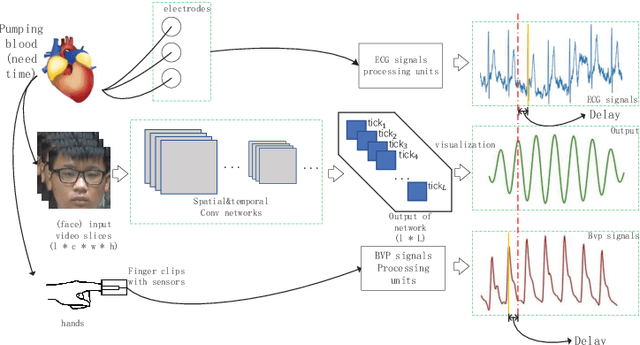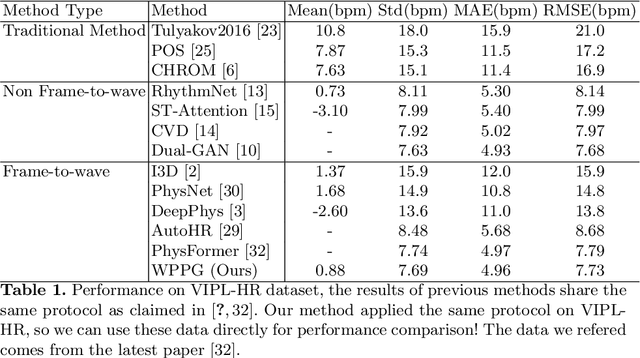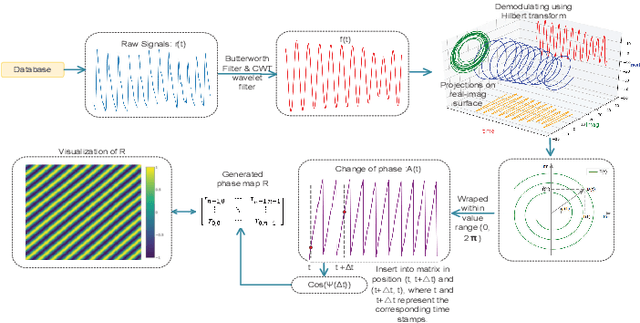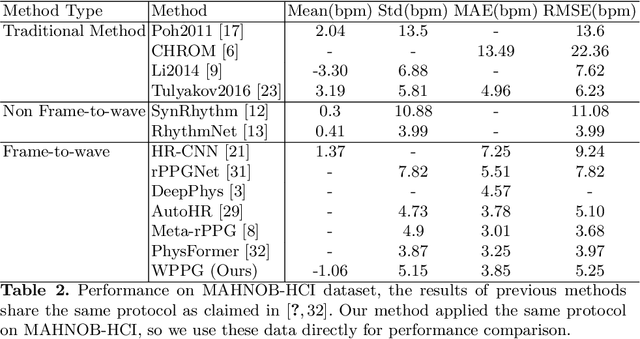Yun Ge
Resolve Domain Conflicts for Generalizable Remote Physiological Measurement
Apr 11, 2024



Abstract:Remote photoplethysmography (rPPG) technology has become increasingly popular due to its non-invasive monitoring of various physiological indicators, making it widely applicable in multimedia interaction, healthcare, and emotion analysis. Existing rPPG methods utilize multiple datasets for training to enhance the generalizability of models. However, they often overlook the underlying conflict issues across different datasets, such as (1) label conflict resulting from different phase delays between physiological signal labels and face videos at the instance level, and (2) attribute conflict stemming from distribution shifts caused by head movements, illumination changes, skin types, etc. To address this, we introduce the DOmain-HArmonious framework (DOHA). Specifically, we first propose a harmonious phase strategy to eliminate uncertain phase delays and preserve the temporal variation of physiological signals. Next, we design a harmonious hyperplane optimization that reduces irrelevant attribute shifts and encourages the model's optimization towards a global solution that fits more valid scenarios. Our experiments demonstrate that DOHA significantly improves the performance of existing methods under multiple protocols. Our code is available at https://github.com/SWY666/rPPG-DOHA.
Self-similarity Prior Distillation for Unsupervised Remote Physiological Measurement
Nov 09, 2023Abstract:Remote photoplethysmography (rPPG) is a noninvasive technique that aims to capture subtle variations in facial pixels caused by changes in blood volume resulting from cardiac activities. Most existing unsupervised methods for rPPG tasks focus on the contrastive learning between samples while neglecting the inherent self-similar prior in physiological signals. In this paper, we propose a Self-Similarity Prior Distillation (SSPD) framework for unsupervised rPPG estimation, which capitalizes on the intrinsic self-similarity of cardiac activities. Specifically, we first introduce a physical-prior embedded augmentation technique to mitigate the effect of various types of noise. Then, we tailor a self-similarity-aware network to extract more reliable self-similar physiological features. Finally, we develop a hierarchical self-distillation paradigm to assist the network in disentangling self-similar physiological patterns from facial videos. Comprehensive experiments demonstrate that the unsupervised SSPD framework achieves comparable or even superior performance compared to the state-of-the-art supervised methods. Meanwhile, SSPD maintains the lowest inference time and computation cost among end-to-end models. The source codes are available at https://github.com/LinXi1C/SSPD.
WPPG Net: A Non-contact Video Based Heart Rate Extraction Network Framework with Compatible Training Capability
Jul 04, 2022



Abstract:Our facial skin presents subtle color change known as remote Photoplethysmography (rPPG) signal, from which we could extract the heart rate of the subject. Recently many deep learning methods and related datasets on rPPG signal extraction are proposed. However, because of the time consumption blood flowing through our body and other factors, label waves such as BVP signals have uncertain delays with real rPPG signals in some datasets, which results in the difficulty on training of networks which output predicted rPPG waves directly. In this paper, by analyzing the common characteristics on rhythm and periodicity of rPPG signals and label waves, we propose a whole set of training methodology which wraps these networks so that they could remain efficient when be trained at the presence of frequent uncertain delay in datasets and gain more precise and robust heart rate prediction results than other delay-free rPPG extraction methods.
 Add to Chrome
Add to Chrome Add to Firefox
Add to Firefox Add to Edge
Add to Edge